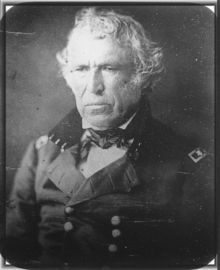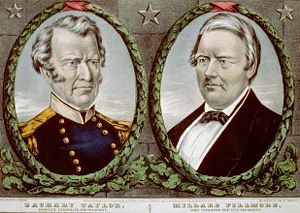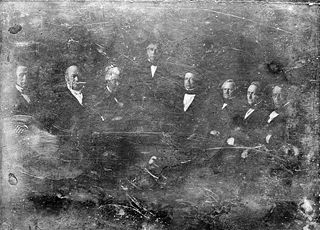Zachary Taylor
2008/9 Schools Wikipedia Selection. Related subjects: USA Presidents
|
Zachary Taylor
|
|
 Daguerreotype of President Taylor taken in 1849 by Matthew Brady |
|
|
|
|
|---|---|
| In office March 4, 1849 – July 9, 1850 |
|
| Vice President | Millard Fillmore |
| Preceded by | James K. Polk |
| Succeeded by | Millard Fillmore |
|
|
|
| Born | November 24, 1784 Barboursville, Virginia |
| Died | July 9, 1850 (aged 65) Washington, D.C. |
| Nationality | American |
| Political party | Whig |
| Spouse | Margaret Smith Taylor |
| Occupation | Soldier ( General) |
| Religion | Episcopal |
| Signature | |
| Military service | |
| Nickname(s) | Old Rough and Ready |
| Allegiance | United States of America |
| Service/branch | United States Army |
| Years of service | 1808-1848 |
| Rank | Major General |
| Battles/wars | War of 1812 Black Hawk War Second Seminole War Mexican-American War * Battle of Monterrey * Battle of Buena Vista |
Zachary Taylor ( November 24, 1784 – July 9, 1850) was an American military leader and the twelfth President of the United States. Known as "Old Rough and Ready," Taylor had a 40-year military career in the U.S. Army, serving in the War of 1812, Black Hawk War, and Second Seminole War before achieving fame leading U.S. troops to victory at several critical battles of the Mexican-American War. A Southern slaveholder who opposed the spread of slavery to the territories, he was uninterested in politics but was recruited by the Whig Party as their nominee in the 1848 presidential election. In the election, Taylor defeated the Democratic nominee, Lewis Cass, and became the second U.S. president never to hold any prior office (George Washington had been the first). Taylor was also the last southerner to be elected president until Woodrow Wilson. (Andrew Johnson became president through succession).
As president, Taylor urged settlers in New Mexico and California to bypass the territorial stage and draft constitutions for statehood, setting the stage for the Compromise of 1850.
Taylor died of acute gastroenteritis just 16 months into his term. Vice President Millard Fillmore then became President.
Early life
Taylor was born on November 24, 1784, in a log cabin in Montebello, near Barboursville in Orange County, Virginia.
He was the third of nine children of Colonel Richard Lee Taylor and Sarah Strother. James Madison was a second cousin and Robert E. Lee was a third cousin once removed (through Colonel Richard Lee the Immigrant). In his infancy, Taylor's family moved to Jefferson County, Kentucky, now Jefferson County ( Louisville Metro) in Kentucky, where Taylor grew up on a plantation called "Springfield", now called the Zachary Taylor House. He was known as "Little Zack" and was educated by private tutors. He was a descendant of King Edward I of England, as well as Mayflower passengers Isaac Allerton and William Brewster.
Taylor met Margaret Mackall Smith of Maryland in early 1810, and they were married on June 21, 1810. They had one son and five daughters, two of whom died in infancy.
- Ann Mackall Taylor ( April 9, 1811 - December 2, 1875)
- Sarah Knox "Knoxie" Taylor ( March 6, 1814 - September 15, 1835)
- Octavia Pannill Taylor ( August 16, 1816 - July 8, 1820)
- Mary Smith Taylor ( July 27, 1819 - October 22, 1820)
- Mary Elizabeth "Betty" Taylor ( April 20, 1824 - July 25, 1909)
- Richard "Dick" Taylor ( January 27, 1826 - April 12, 1879), Confederate States Army General
Military career
On May 3, 1808, Taylor joined the U.S. Army, receiving a commission as a first lieutenant of the Seventh Infantry Regiment from his cousin James Madison. He was ordered west into Indiana Territory, taking command at the Battle of Fort Harrison; he was promoted to captain in November 1810.
During the War of 1812, Taylor became known as a talented military commander. Assigned to command Fort Harrison on the Wabash River, at the northern edge of present-day Terre Haute, Indiana, he successfully commandeered a small force of soldiers and civilians to stave off a British-inspired attack by about 500 Native Americans between September 4 and September 15. The Battle of Fort Harrison, as it became known, has been referred to as the "first American land victory of the War of 1812." Taylor received a brevet promotion to major on October 31, 1812. Taylor was promoted to lieutenant colonel on April 20, 1819, and colonel on April 5, 1832.
Taylor served in the Black Hawk War (May-August 1832) and the Second Seminole War (1835-1842). During the Seminole War, Taylor fought at the Battle of Lake Okeechobee and received a brevet promotion to brigadier general in January 1838. It was here he gained his nickname "Old Rough and Ready" for his rumpled clothes and wide-brimmed straw hat. On May 15, 1838, Taylor was promoted commanding general of all U.S. forces in Florida.
James K. Polk sent the Army of Occupation under Taylor's command to the Rio Grande in 1846. After the Thornton Affair, an incident in disputed territory in which Mexician troops killed and captured a squadron of the 2nd dragoons, Polk urged Congress to declare the Mexican-American War. In that conflict Taylor won an important victory at the Battle of Monterrey and lead the U.S. army at the Battle of Buena Vista, becoming a national hero.
Polk kept Taylor in Northern Mexico, disturbed by his informal habits of command, particularly his decision to negotiate a ceasefire at Monterrey against Polk's wishes, and his affiliation with the Whig Party. He sent an expedition under General Winfield Scott to capture Mexico City. Taylor, incensed, thought that "the battle of Buena Vista opened the road to the city of Mexico and the halls of Montezuma, that others might revel in them."
Election of 1848
Taylor received the Whig nomination for President in 1848. Millard Fillmore of Cayuga County, New York was chosen for the Vice Presidential nominee. Like many other army officers, Taylor was nonpolitical and had never voted. His homespun ways and his status as a war hero were political assets. Taylor defeated Lewis Cass, the Democratic candidate, and Martin Van Buren, the Free Soil candidate.
To the astonishment of Whigs, Taylor ignored their platform, as historian Michael Holt explains:
Taylor was equally indifferent to programs Whigs had long considered vital. Publicly, he was artfully ambiguous, refusing to answer queries about his views on banking, the tariff, and internal improvements. Privately, he was more forthright. The idea of a national bank "is dead, and will not be revived in my time." In the future the tariff "will be increased only for revenue"; in other words, Whig hopes of restoring the protective tariff of 1842 were vain. There would never again be surplus federal funds from public land sales to distribute to the states, and internal improvements "will go on in spite of presidential vetoes." In a few words, that is, Taylor pronounced an epitaph for the entire Whig economic program.
Presidency
Policies
Although Taylor had subscribed to Whig principles of legislative leadership, he was not inclined to be a puppet of Whig leaders in Congress. He ran his administration in the same rule-of-thumb fashion with which he had fought Native Americans.
Under Taylor's administration, the United States Department of the Interior was organized, although the legislation authorizing the Department had been approved on President Polk's last day in office. He appointed former Treasury Secretary Thomas Ewing the first Secretary of the Interior.
The Compromise of 1850
The slavery issue dominated Taylor's short term. Although he owned slaves, he took a moderate stance on the territorial expansion of slavery, angering fellow Southerners. He told them that if necessary to enforce the laws, he personally would lead the Army. Persons "taken in rebellion against the Union, he would hang ... with less reluctance than he had hanged deserters and spies in Mexico." He never wavered. Henry Clay then proposed a complex Compromise of 1850. Taylor died as it was being debated. (The Clay version failed but another version did pass under the new president, Millard Fillmore.)
Administration and Cabinet
| The Taylor Cabinet | ||
|---|---|---|
| Office | Name | Term |
| President | Zachary Taylor | 1849–1850 |
| Vice President | Millard Fillmore | 1849–1850 |
| Secretary of State | John M. Clayton | 1849–1850 |
| Secretary of Treasury | William M. Meredith | 1849–1850 |
| Secretary of War | George W. Crawford | 1849–1850 |
| Attorney General | Reverdy Johnson | 1849–1850 |
| Postmaster General | Jacob Collamer | 1849–1850 |
| Secretary of the Navy | William B. Preston | 1849–1850 |
| Secretary of the Interior | Thomas Ewing, Sr. | 1849–1850 |
Surviving family
- Taylor's son Richard became a Confederate Lieutenant General, while his daughter Sarah Knox Taylor (1814–1835) had married future President of the Confederate States Jefferson Davis three months before her death of malaria.
- Taylor's brother, Joseph Pannill Taylor, was a Brigadier General in the Union Army during the Civil War. (Joseph P. Taylor's son Joseph Hancock Taylor was a US Colonel in the Civil War and was also a son-in-law of Union General Montgomery C. Meigs).
- Taylor's niece Emily Ellison Taylor was the wife of Confederate General Lafayette McLaws.
- Ann Taylor's son John Taylor Wood, a U.S. Navy officer, defected to the Confederate side and later fled to Canada during the Civil War; his great-grandson Zachary Taylor Wood was Acting RCMP Commssioner, great-great-grandson Stuart Taylor Wood was Commissioner of the Royal Canadian Mounted Police and great-great-great-grandsons (Cst. Herschel Wood and Supt.(Ret) John Taylor Wood served in the RCMP.



